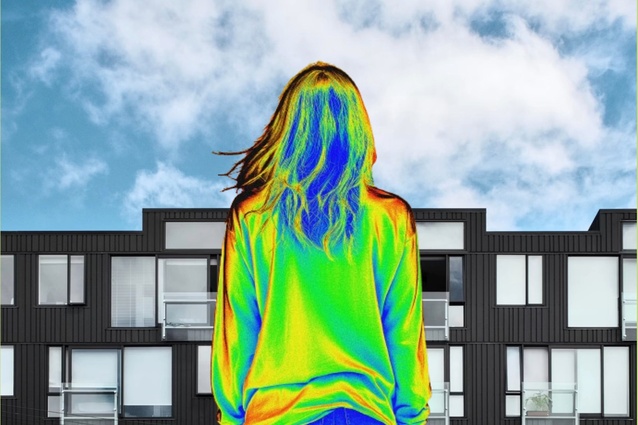Cooked
Architecture NZ editor Chris Barton asks why we are designing houses that overheat.
If you can’t stand the heat, get out of, not just the kitchen, but the house. In June, The New Zealand Herald reported how a tenant did just that — managing to break their year-long lease just a month after moving in, following a complaint to the Tenancy Tribunal about excessive heat in their sixth-floor one-bedroom apartment. The Tribunal heard evidence of a day in March this year when the temperature inside the east-facing unit reached a dangerously hot 43.6°C before midday. The next day, it reached 38.5°C before 9am, even with the living room window open and after the air conditioning had been running. The tenant claimed the windows in the apartment did not open wide enough to allow sufficient draught. The landlord suggested the tenants “had not been using them properly” and produced a Healthy Homes Standards report showing compliance with the applicable ventilation requirements.
The landlord’s temperature readings in the living room with the curtains closed and then open showed lower, but still uncomfortably high, afternoon temperatures of 26.4°C and 28.3°C respectively. The Tribunal ordered the $2440 bond be returned to the tenant, plus partial reimbursement of extra electricity charges to run air conditioning. Following the Tribunal’s ruling, an agreement was reached between the tenant and landlord to end the lease earlier than the contracted date. A new tenancy began on 11 April. One hopes it came with a health warning.
That the Tribunal is receiving complaints like this shouldn’t come as a surprise. The writing has been on the outside walls and windows of our houses for some time. A 2018 Stats NZ survey of 6700 homes found 36 per cent were sitting at 25°C or higher over summer, sometimes above 30°C (the comfortable range being 20°C to 25°C).
More recently, there was the 2024 Auckland Council technical report, Life in Medium Density Housing in Tāmaki Makaurau / Auckland, which surveyed 1337 medium-density housing (MDH) residents about their living conditions, focusing on code of compliance homes built between 2016 and 2023. It found the upper levels of terraced houses and duplexes were too hot in summer. Participants were dissatisfied with the hot temperatures as they caused uncomfortable sleeping and could lead to heat-related health implications. Participants also reported making changes to cool their homes, such as keeping curtains closed, windows open, purchasing free-standing fans and air-conditioning units, or installing ceiling fans, heat pumps and air-conditioning units.
The findings were similar to those of a 2007 study by the Building Research Association (BRANZ) of 400 homes; it found that newer buildings were going above the comfortable temperature of 25°C and warned that climate change was only going to make this problem worse.
The Herald, “if the recent changes are workable and not contributing to unintended consequences like overheating or unreasonable additional costs”. Penk copped considerable flak for his comments — “unbelievably shortsighted”, “another step backwards”, “misguided”. Many, including BRANZ and the Green Building Council, pointed out that poor design — insufficient ventilation, a lack of shading or too much glass to the north — not insulation, is the problem.
As Green Building Council business development manager Matthew Cutler-Welsh explained, the real issue is that “our woeful Building Code doesn’t consider overheating at all”. Again, this isn’t new. As BRANZ points out, researchers have been saying for nearly 25 years that our Building Code needs to include standards for cooling homes. It’s worth noting that the recently introduced Healthy Homes Standards, while requiring aspects of ventilation, also don’t explicitly address overheating.
By May, Penk had changed his view: “It seems to me that the ventilation part of the Building Code needs an update and obviously the insulation, or rather the energy efficiency element, has been addressed in the sense of the H1 rules,” he told Radio NZ. “It seems to me that with all the expertise that’s available, this is something that New Zealand Inc. could have contemplated and considered and actively avoided,” he said. “We’ve got to see a regime where people aren’t being cooked alive in their own house.”
Indeed, we do. Just ask the Brits. In August last year, it was reported that some 4.5 million Britons have been so hot in their homes during periods of hot weather that it has made them unwell. The condition, dubbed the ‘hot house syndrome’, is a result of inadequate insulation in old building stock, poor ventilation and other factors that contribute to overheating.
What’s particularly worrying about New Zealand’s situation is that we are still designing large numbers of MDH new builds to overheat. To really solve this problem in the wider context of increasing temperatures caused by climate change will need more than fiddling with ventilation requirements in the Building Code. We need a design-led Code that looks at the whole building — windows, walls, shading, insulation, etc. and how it performs — not in relation just to overheating but, also, to lowering carbon emissions. If we don’t, well…, we’re cooked.











